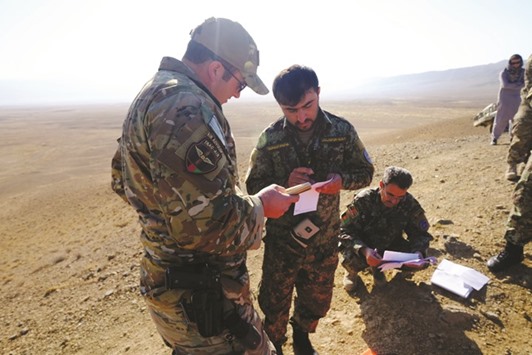The alliance has shifted most military responsibility on to Afghanistan’s armed forces since it ended its main combat mission after 2014, including building up air capabilities that are crucial to holding back Taliban gains.
A growing number of mainly small Afghan aircraft have been firing increasingly powerful weapons at militants with little or no guidance from the ground, a problem that US advisers like Lieutenant Colonel Andy Janssen are trying to address.
“When you’re in the air, the picture of what’s going on is vastly different than when you’re on the ground,” he said during a recent training exercise in Logar province, just south of the capital Kabul.
“The ability to talk a pilot’s eyes to the target effectively is huge. The effectiveness of the strikes goes up exponentially when you do that.”
About 60 students are currently at various levels in the programme, with officials hoping to field nearly 100 so-called Afghan Tactical Air Controllers (ATACs) by March next year, in time for an expected seasonal upswing in Afghan Taliban fighting after mountain snows melt.
While air “spotters” are no guarantee that the right target will be hit, greater accuracy from air strikes is crucial on two fronts.
Afghan ground forces have struggled to contain a stubborn insurgency that is fighting to topple the Western-backed government and drive out foreign troops, and their reliance on effective air support is increasing.
And civilian casualties from air strikes have spiked this year, with 133 Afghans killed and 159 wounded in the first nine months of 2016, 72% up from the same year-ago period.
While no separate data were available for attacks carried out by Afghan, US or Nato aircraft, the United Nations said two-thirds of this year’s civilian casualties were caused by the local air force.
The UN also said Afghanistan had 41 aircraft capable of conducting air strikes by June, up from 28 at the end of last year.
At a military range in Logar, students and pilots practise co-ordinating air strikes as warplanes and helicopters blast old cars set as targets on the ground.
The trainees used compasses, laser range finders, GPS devices and what Janssen called “very complicated” radios.
Unlike American soldiers, who may undergo years of specialised certifications to direct air strikes, Afghans in the programme will be deployed after five to six weeks of training, although instructors say they will receive more advanced training later.
Like the Afghan air force more broadly, which only began to expand rapidly in the last two years, the ATAC programme has had a slow start.
In an initial programme, soldiers were pulled from existing army units for training as ATACs, said Colonel Troy Henderson, commander of the US Air Force’s expeditionary advisory group in Kabul.
When they returned, however, many went back to other army jobs, rather than working to co-ordinate air cover.
Under the new programme, initiated in March, ATACs have been assigned directly to the air force, allowing them to focus on their specialised role, he added.
Janssen said the reforms were already paying off, with deployed ATACs playing a more effective role in air operations.
During a recent operation in northern Afghanistan, an Afghan aircraft was 30 seconds from launching an air strike when an ATAC called it off because two goat herders had walked into the area.
“If the ATAC hadn’t been there, then there could have possibly been a couple civilians hurt from the strike,” Janssen said.
As the Taliban insurgency has spread, and Afghans have less access to back-up from US planes and helicopters, civilian casualties caused by the Afghan air force have surpassed those attributed to international air strikes for the first time.
Other incidents this year have claimed the lives of Afghan soldiers and police caught in so-called “friendly fire” air strikes.
The ATAC trainees see their role as key to preventing more deaths in errant air assaults.
“We can take our co-ordinates and the enemy co-ordinates to prevent civilian casualties and hitting the wrong target,” said Lieutenant Mohammad Akram, one of the trainees, after he practised guiding in a bomb. “This is our duty, to save
people’s lives.”



